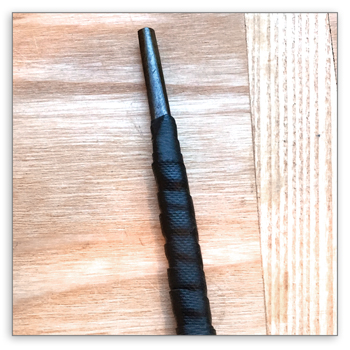A taping tip for ergonomic bench tools
By Helen I. Driggs
Using tools incorrectly or tools that are uncomfortable to hold not only makes working unpleasant, but also can lead to repetitive stress injury. To prevent tendon, bone, or nerve damage, it is important to choose tools to fit both the job and your hand. And when a bench tool doesn’t fit your body well during long work hours, you can often easily adjust it.

I recently procured a large set of vintage old steel chasing punches, and I love them. Each punch has a wonderful shape and the tips are beautifully finished and made from highly polished, hardened steel. Hardened steel equals good news for a long lasting tool, but bad news when it’s square rod, because those punches always hurt my hand if I use them for more than 10 minutes or so. The edges are sharp, and the small diameter of the tool rod makes them very unpleasant to use. I easily fixed this problem using 3M Electrician’s Splicing tape from the hardware store. It is a rubberized, stretchy, thick tape with an adhesive strip on one side that can help transform a once-painful tool into one that can be used for many pain-free hours.

1. Ensure there is no grease, wax, or oil on the tool shaft, and that the steel is dry.

2. Working off the roll of tape, peel back a short section of backing strip and position the tape on the lower end of the tool shaft. Hold the tape firmly with your thumb.

3. Stretch the tape as you simultaneously wrap it around the tool shaft, peeling off the adhesive film as you go. This works best in a warm room, because the rubber tape will be more flexible and stretchy.

4. Spiral up the shaft of the tool to about 3/4-inch to the end, and snip the tape from the roll.

5. Stretch the tape as far as you can for the last wrap, ensuring the tape is being wrapped on the previous layer of tape so the rubber sticks to itself.

6. Those once-sharp tool steel edges are now padded and more comfortable to use. In addition, the tape has enlarged the diameter of the tool, making it more ergonomically correct and less likely to stress the tendons of your hand.

7. Splicing tape can also be used for pliers, hammers, scissors, and hand tools that re-quire a strong grip for a long period of time. The tape is easily removed with a utility knife, and any residue can be wiped away with some acetone and a cotton cloth.